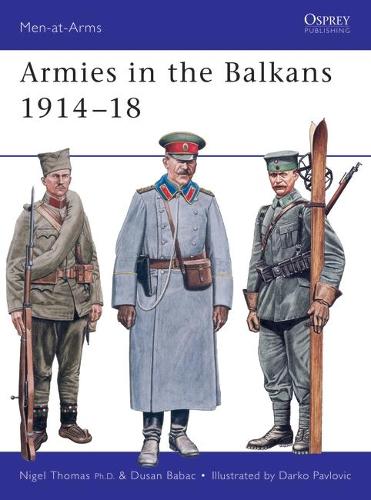
Armies in the Balkans 191418
(Paperback)
Publishing Details
Armies in the Balkans 191418
By (Author) Nigel Thomas
Illustrated by Darko Pavlovic
By (author) Dusan Babac
Bloomsbury Publishing PLC
Osprey Publishing
25th July 2001
United Kingdom
Classifications
General
Non Fiction
First World War
War and defence operations
Land forces and warfare
Military institutions
940.414
Physical Properties
Paperback
48
Width 184mm, Height 248mm, Spine 5mm
196g
Description
Recent history should remind us that it was events in the Balkans which sparked off the Great War, with the assassination of the Austrian heir Prince Franz Ferdinand in Sarajevo, and the consequent invasion of Serbia by Austro-Hungarian armies on 2 August 1914. Nevertheless, the subsequent four-year war in that theatre is always overshadowed by the simultaneous campaigns on the Western Front. For the first time this book offers a concise account of these complex campaigns, the organisation, orders of battle, and the uniforms and insignia of the armies involved: Austro-Hungarian, German, Ottoman, Serbian, Montenegrin, Albanian, British, French, Italian, Russian, Bulgarian, Greek and Rumanian.
Author Bio
DR. NIGEL THOMAS is an accomplished linguist and military historian and is currently a Senior Lecturer in charge of the Business Language Unit at the University of Northumbria, Newcastle. His interests are 20th century military and civil uniformed organizations, with a special interest in Germany, Central and Eastern Europe. He was recently awarded a PhD on the Eastern Enlargement of NATO. DU=AN BABAC is a postgraduate geological engineer, living in Belgrade. He has a strong interest in military history, particularly military uniforms, and is an acknowledged authority on Yugoslavia and Montenegro. He is an associate of the Military Mudeum and Serbian History Museum in Belgrade and has published widely in France, Japan, Russia and the states of former Yugoslavia. This is his first book for Osprey. DARKO PAVLOVIC is a Croatian artist living and working in Graz, Austria and Zagreb. He is an architect with a passion for military history and is now a full-time illustrator specializing in military subjects.
